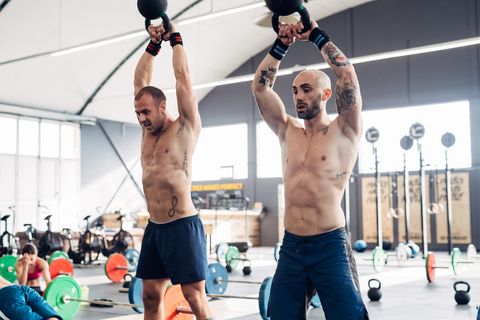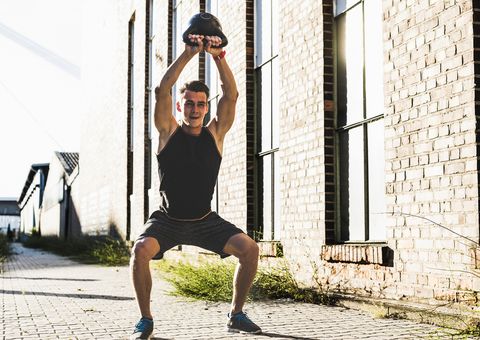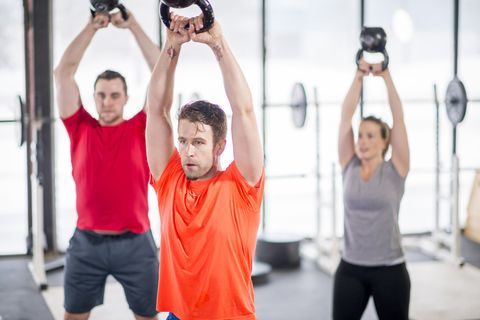Don't Ever Do the American Kettlebell Swing. Here's Why.
Most exercises you do have a purpose. They’re smart and well-thought-out, and they push you towards your fitness goals in the safest ways possible, mirroring the ways the body can move and in many cases, protecting you from yourself.
And then there’s the American kettlebell swing, which is absolutely none of these things.
Instead, it’s the kettlebell swing you should never do, a move that has no business in your fitness repertoire. (It’s everything that’s wrong with 2019 fitness class culture, too, where poorly equipped trainers push you to do American swings because they don’t really know any better — and you listen because your trainer should know better.)
Not all swings are bad — just the American swing, for reasons I’ll break down right now. The classic kettlebell swing, the Russian swing, is a fundamental exercise that every guy should do. It’s an explosive and natural expression of hip extension, a key portion of your vertical leap and your sprinter’s stride, too.
It’s easy and natural to learn. You stand grasping a kettlebell with both hands, core tight, toes pointed ever-so-slightly outward, knees slightly bent. From there, you push your butt back slightly and hinge at the waist, letting momentum take the kettlebell behind your thighs. Then you stand up explosively and squeeze your glutes. Momentum carries the kettlebell upwards and in front of you, and your arms drive forward, typically until they’re parallel to the ground, in the process.
It’s a simple move that safely targets the muscles most guys need to work (glutes and hamstrings), keeping the emphasis on those muscles when you chain multiple reps together. It’s a flawless exercise (and if you want to learn it, the video below has got you covered).
So What’s the American Swing?

Eugenio MarongiuGetty Images
Think of the American swing as an unnecessary attempt to upgrade that exercise. Somewhere along the line, somebody decided the swing somehow wasn’t good enough. Then CrossFit embraced the American swing, and then obviously it was awesome, because, hey, “CrossFit.”
The American swing is very much like the classic swing in its mechanics, except it has a different end goal: The kettlebell winds up overhead. The bottom of the bell should face the ceiling at the top of each rep.
In theory, you’re exploding from your hips that much more to power the kettlebell into the overhead position, strengthening your hip extension pattern and your glutes and hamstrings even more. But it’s all theory. In practice, the American swing frequently takes the emphasis off your hammies and glutes, and average gym-goers over-involve muscles that aren’t meant for the job, such as the shoulders and lower back. The result? Injuries.
In general, you always want to choose exercises that minimize risk and maximize the benefits that’ll push you to your goals. You should evaluate all exercises this way (and not be afraid to question your group fitness trainer either — it’s their job to answer you). I try to keep that in mind in all the workouts I post.
And there are simply too few benefits (read: none) to the American swing.
Why People Want to Love the American Swing
American swing fans have two key arguments that fail to account for the way the general population actually moves.
Maybe (maybe!) it’s a demonstration of true shoulder extension at the top of each rep, that your mid- and upper-back muscles will fire. In this way, it’s a total body exercise, and superior and more “complete” than the Russian kettlebell swing.
Thing is, your average human (that phrase will get me killed by some fitness folks, but those folks forget that not everyone’s super-fit) can’t truly get their shoulders directly overhead (more on that later). So that means, by default, they’re destined to perform the American swing incorrectly (and I’ve seen “fit” folks wreck this move, too).
The big claim by CrossFit is you’re doing “more work”. (And more work is always better; your boss will love that one.) Two problems here: First off, more work isn’t always better. If it was, we’d ditch the deadlift entirely and only do snatches (another exercise that, you know, not all humans can effectively do). Based on “more work is better” theory, a deadlift has you stopping the moment your glutes and hamstrings are done working. And a deadlift is also a key part of the snatch.
So why not only train the snatch? Answer: Because deadlifts and deadlift variants (oh, and Russian swings) target, among other bodyparts, the hamstrings and glutes, driving them to grow and grow more powerful. Targeting muscles is important, even if “all-workouts-should-be-total-body” nation doesn’t understand that, because it’s a key method of correcting weaknesses in both your mechanics and your physique.
How the American Swing Wrecks You
View this post on Instagram
A post shared by Vasilij (@vasilij.zhernakov) on
Quick test: Lie with your belly on the ground, arms and legs long in front of you. Now raise your arms off the ground as high as possible. Did your chest rise off the ground too? Did you tighten your lower back a bit to do this? Or were you able to do this moving only at your shoulders?
Many people won’t be able to do this cleanly. Even if they can, they’ll have to think about it. Driving the shoulders into true overhead position isn’t as natural as you may think. It’s not just shoulder strength; it’s stability and control of your shoulder blades and the small muscles around them.
When forced to hit a true arms-directly-overhead position, many people compensate with movement in other areas, often arching their upper or (worse!) lower backs. Or they try to force their shoulder muscles to do the work — except the shoulder muscles can’t handle the responsibility.

Use too much resistance and things get worse. And inherent to the American swing is a load that’s frequently too much for the shoulders. The basic swing lets you move a fairly heavy weight, since it relies on two of your body’s most powerful muscle groups, the legs and glutes, to generate the majority of the force.
If those muscle groups can’t power the bell to the dumb American standard, the shoulders and lower back do the brunt of the extra work — except they’re not meant to move the same load as the glutes and hammies. So the shoulder muscles and smaller upper-body stabilizers take over that large load.
The American swing crowd might contend that this isn’t all that different from a snatch anyway, hamstrings and glutes firing. Thing is, both the barbell and single-arm snatch versions let you drive weights overhead while rotating and spreading your shoulders more freely to create joint space for your rotator cuff tendons. That can’t happen when both hands are grasping a kettlebell handle with a close grip.
It’s Worse in Fitness Classes

FatCameraGetty Images
Why do any of this, then? Well, just don’t. Don’t do it because CrossFit. And definitely don’t do it because some trainer preening for Instagram has it in a program, which happens too often in fitness classes, especially if they’re inspired by “functional fitness”.
In fitness class settings, the American swing’s even more dangerous. Really think and focus in on the American kettlebell swing, be super-controlled and mindful of your whole body, and you have your best shot.
In fitness classes, especially HIIT-based ones, you can’t do that. They rely on high rep loads, and, eventually, fatigue piles on. Station-to-station randomness makes things worse: if the American swing’s your first move, your mind and your shoulder blades aren’t fatigued. If it’s last, the muscles that govern your shoulder blades may not properly depress and retract them, leading to form breaks when overhead that prime your shoulders for serious injury.
You could go “lighter” on the weight with the American swing, both in a class setting and in your own workouts, focusing on form. Except then, your hamstrings and glutes, the targets of the classic swing, simply don’t get to move as much weight. In the pursuit of “more work,” the target muscles of the classic move get a less effective chance to do work.
Your American Swing Alternative

Yuri_ArcursGetty Images
Unless you compete in CrossFit (where the American swing sometimes shows up in competition), the wildest part about the stupidity of the American kettlebell swing is that there’s a much simpler way to achieve the super-aggressive hip extension and explosive glute contraction that it is supposed to bring. There’s a smarter, less injury-inducing way to push your glutes and hamstrings to “pop” more than they do on your average Russian swing.
What’s the game plan? Do the Russian swing with a heavier kettlebell.
Source: Read Full Article


